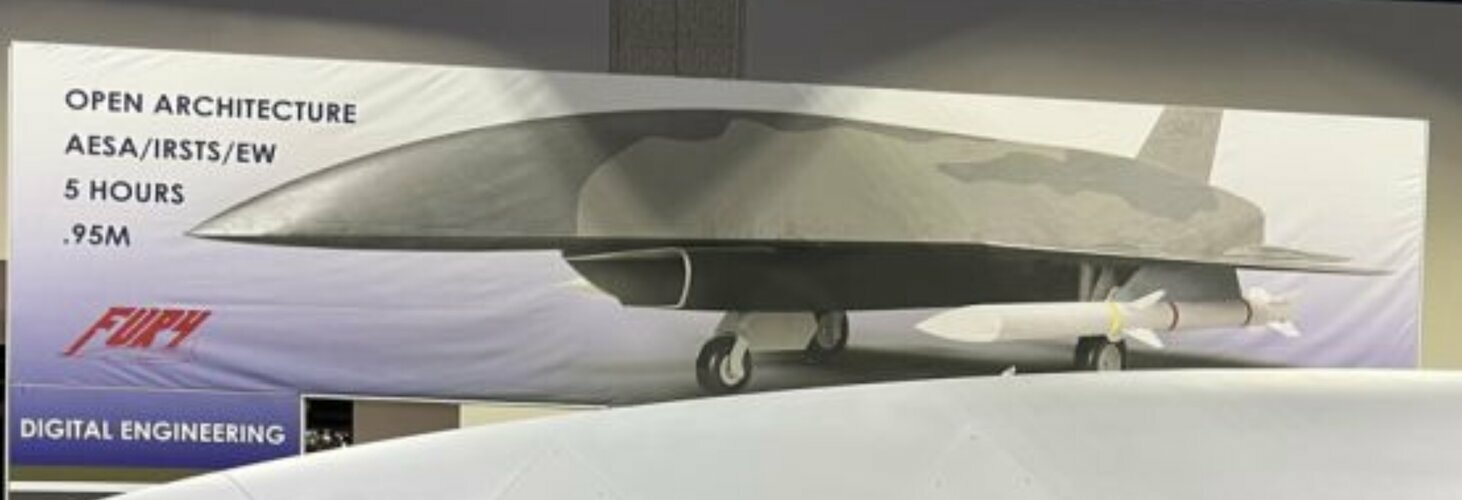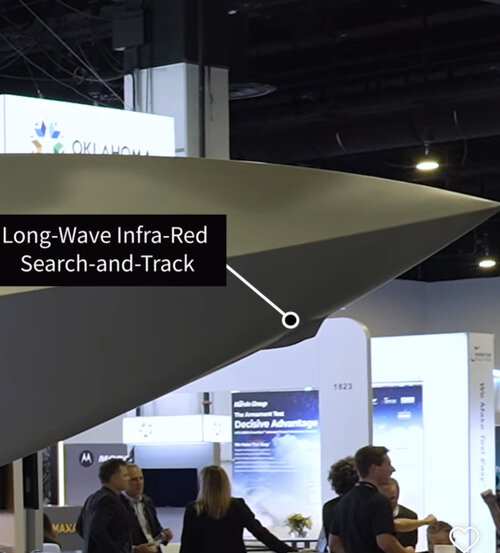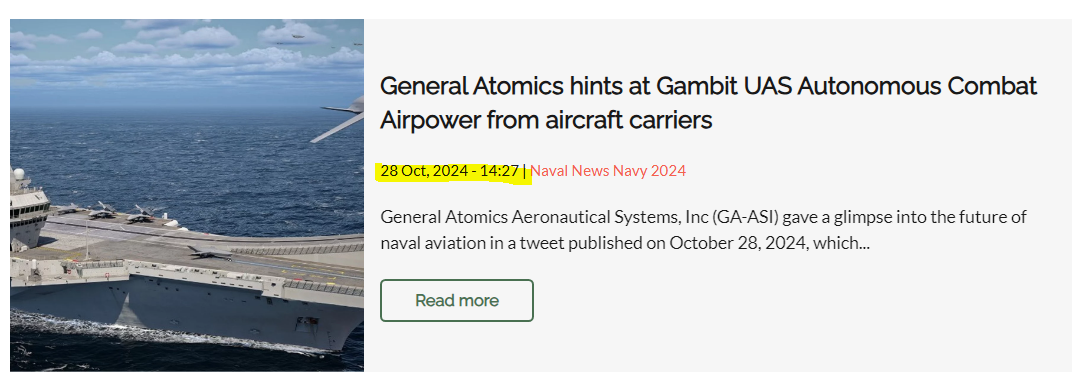You are using an out of date browser. It may not display this or other websites correctly.
You should upgrade or use an alternative browser.
You should upgrade or use an alternative browser.
US UAV and UCAV Technology
- Joined
- 24 November 2008
- Messages
- 1,545
- Reaction score
- 2,586
Small wings, external weapons... Enough to keep up with the combat range of manned fighters?
Explorer121
ACCESS: Restricted
- Joined
- 17 June 2024
- Messages
- 22
- Reaction score
- 61
It could be primarily intended as an off board sensing station and decoy, and if they use peregrines for the external weapons it might make more sense. (Replace AMRAAM in picture with peregrine)Yes, external carriage would be a nay-sayer unless they have the math for it. But are we sure the late Fury doesn´t have any wb?
Attachments

Experts: CCA Drones Could Cost Less Than $1,200 per Pound
Contractors want Collaborative Combat Aircraft (CCA) to cost less than $1,000 per pound, panelists said at the Air, Space & Cyber Conference.www.airandspaceforces.com
Interesting info at the bottom of that report:
Even if CCAs were not “affordable mass,” they would be worth pursuing because they open up new tactical possibilities and allow the Air Force to “take risks we wouldn’t take with something that has a person in it.”
Kunkel noted that an experimental unit has been created at Nellis Air Force Base to put CCA technology in the hands of operators and let them experiment with it to find new possibilities for battlefield use.
“This is not a test unit, this is an operational unit. And the thought is, bring in our warfighters that have some experience with this from all different backgrounds. And not only the flyers that would actually fly and develop tactics, but also folks on the ground, so we can learn exactly what we need from an autonomy perspective.”
Also
Last edited:
Explorer121
ACCESS: Restricted
- Joined
- 17 June 2024
- Messages
- 22
- Reaction score
- 61
And XQ-67 was never A2A, but here we are. This all honestly makes me feel a bit nervous about the effectiveness of increment 1, but I guess the goal here is to drive down costs as much as possible and get started on doctrine and strategy for the whole kill-web thing, not create the best possible version of it by 2040.Fury never was an OBSS platform. Changing AMRAAMS for [non-existent] Peregrines will add a little + in terms of Cx and RCS if any.
- Joined
- 1 April 2006
- Messages
- 11,337
- Reaction score
- 9,980
Here? Are there any proof or statements on weapons carriage provisions for -67?And XQ-67 was never A2A, but here we are.
Explorer121
ACCESS: Restricted
- Joined
- 17 June 2024
- Messages
- 22
- Reaction score
- 61
XQ-67 was for OBSS, but demonstrated the 'genus' system's common drone core. The Fury was a target drone/simulated enemy but integrated Anduril's Lattice AI hardware. They're both being shown off as CCA's but they were originally designed for similar but different roles. The thing that was supposed to tie them all together was the NGAD manned component, but that seems to have fallen through or been delayed. Nothing says that an airframe has to do the job it was designed for, but if it was designed for the job it's doing it'll probably do it better. I'm somewhat optimistic about the gambit system allowing GA to upgrade the airframe separately from a full procurement round.

CCA Contract Expected in Fall; First Versions Under Construction
The Air Force is expected to award one or two Collaborative Combat Aircraft (CCA) contracts this fall, toward fielding hardware in two years.
An industry source said AFRL also planned an Off Board Weapon Station (OBWS) program that would partner with the OBSS as a hunter-killer two-aircraft system—but that has been subsumed into the CCA effort.
dark sidius
ACCESS: Top Secret
- Joined
- 1 August 2008
- Messages
- 1,171
- Reaction score
- 1,035
They must stop thinking that CCA is the holy Grail , Lockheed say thay will not survive in a contested conflict if they have not a high degre of stealth, they must put the budget on the NGAD fighter what ever it is.And XQ-67 was never A2A, but here we are. This all honestly makes me feel a bit nervous about the effectiveness of increment 1, but I guess the goal here is to drive down costs as much as possible and get started on doctrine and strategy for the whole kill-web thing, not create the best possible version of it by 2040.
- Joined
- 28 January 2008
- Messages
- 979
- Reaction score
- 2,072
CCA's could be tied to any platform provided the host platform has the avionics and software to support the CCA mission package(s), not just the NGAD, whenever NGAD occurs. Hopefully, the CCA mission or missions are defined well enough. CCAs will probably be available well before an NGAD contract is let.
CCA is turning out to be much smaller UCAV-type air vehicles and "potentially" attritable. Definitely for air to ground, a standoff platform type of remote interceptor or ISR potentially. I know Long Shot or the Flying Missile Rail are also other mission aspects as well.
Then you have CCA Increment II which Boeing, NG and LM will be pursuing and probably will be larger airframes with more range and payload. It will be interesting to see how these programs progress. I still believe the disruption in the NGAD decision or it's configuration still may be smoke and mirror disinformation for our enemies, there have been some very large company infrastructure projects at LM and Boeing so NGAD may more along than anyone knows.
CCA is turning out to be much smaller UCAV-type air vehicles and "potentially" attritable. Definitely for air to ground, a standoff platform type of remote interceptor or ISR potentially. I know Long Shot or the Flying Missile Rail are also other mission aspects as well.
Then you have CCA Increment II which Boeing, NG and LM will be pursuing and probably will be larger airframes with more range and payload. It will be interesting to see how these programs progress. I still believe the disruption in the NGAD decision or it's configuration still may be smoke and mirror disinformation for our enemies, there have been some very large company infrastructure projects at LM and Boeing so NGAD may more along than anyone knows.
Forest Green
ACCESS: Above Top Secret
- Joined
- 11 June 2019
- Messages
- 9,271
- Reaction score
- 16,770

CCA: How partners — and foes — are developing their own loyal wingman drones - Breaking Defense
China, Russia, Australia, the United Kingdom and the US Navy are also seeking their own CCA-like loyal wingman military drones.
CCA's could be tied to any platform provided the host platform has the avionics and software to support the CCA mission package(s), not just the NGAD, whenever NGAD occurs. Hopefully, the CCA mission or missions are defined well enough. CCAs will probably be available well before an NGAD contract is let.
CCA is turning out to be much smaller UCAV-type air vehicles and "potentially" attritable. Definitely for air to ground, a standoff platform type of remote interceptor or ISR potentially. I know Long Shot or the Flying Missile Rail are also other mission aspects as well.
Then you have CCA Increment II which Boeing, NG and LM will be pursuing and probably will be larger airframes with more range and payload. It will be interesting to see how these programs progress. I still believe the disruption in the NGAD decision or it's configuration still may be smoke and mirror disinformation for our enemies, there have been some very large company infrastructure projects at LM and Boeing so NGAD may more along than anyone knows.
How cool would it be if they build NGAD in secret? Frisbees of Dreamland vibes. It's probably impossible to build a multi-hundred-billion-dollar project without anybody knowing, though. Too many people involved, facilities too large, too many contracts, too much money appropriated. Even China probably couldn't do this without anybody figuring out (or making an educated guess) what's going on.
aonestudio
I really should change my personal text
- Joined
- 11 March 2018
- Messages
- 2,959
- Reaction score
- 7,454

Sensor Suite Upgrade Reaches New Heights
DUGWAY PROVING GROUND, Utah - Soldiers from 7th Infantry Division training at Dugway Proving Ground get an upgrade to their ability to detect and neutra...
Airbus A340
ACCESS: Confidential
- Joined
- 1 August 2020
- Messages
- 64
- Reaction score
- 95
What kind of range do these things have? Some of them look like they carry their payload externally. Another issue is that in studies, it is assumed that these aircraft can use dispersed basing. This is the best study I found on dispersed basing.
Dispersed basing study
Another study
Dispersed basing study
Another study
- Joined
- 28 January 2008
- Messages
- 979
- Reaction score
- 2,072
We've done it before. You can complete the design, integration, flight test vehicle assembly/ground test then classified flight testing but after that you may have to acknowledge the program, maybe. The so-called RQ-180 is a good example, all developed, flight tested and probably operational in secret except for some lucky sightings with photos in which the USAF won't comment. The NGAD demonstrator(s) 12-month project was/were done in this manner.How cool would it be if they build NGAD in secret? Frisbees of Dreamland vibes. It's probably impossible to build a multi-hundred-billion-dollar project without anybody knowing, though. Too many people involved, facilities too large, too many contracts, too much money appropriated. Even China probably couldn't do this without anybody figuring out (or making an educated guess) what's going on.
Forest Green
ACCESS: Above Top Secret
- Joined
- 11 June 2019
- Messages
- 9,271
- Reaction score
- 16,770

CCA: What weapons and engines will let loyal wingmen drones hit their potential? [VIDEO] - Breaking Defense
WASHINGTON — When talking about aircraft, it’s easy to focus on the main body of the plane itself. But in many cases, it’s the subsystems that make a capability reach its full potential. That’s true for drones as well as manned jets, meaning whether the US Air Force’s Collaborative Combat...
View: https://www.instagram.com/reel/DAoaezXPtBn/?igsh=NjRhM2sxaDByeGp2
So GA’s CCA does have a long-wave IRST.
So GA’s CCA does have a long-wave IRST.
Attachments
Forest Green
ACCESS: Above Top Secret
- Joined
- 11 June 2019
- Messages
- 9,271
- Reaction score
- 16,770

Us Army Unveils Autonomous Drone Capable of Months-Long Surveillance Missions
US Army Unveils Autonomous Drone Capable of Months-Long Surveillance Missions
- Joined
- 9 October 2009
- Messages
- 21,841
- Reaction score
- 13,373
I was just reading the Mitchell Institute's CCA wargame study from February of this year. The takeaway is that the BLUFOR players wanted cheap, expendable CCAs at the start of a Taiwan scenario to attrit PLA airpower and sap their combat strength in the first 2 days. These cheap CCAs would be ground-launched from distributed bases in the Phillipines and Ryukyu islands and air-launched from B-52s and F-15s. Most would carry 2 AMRAAMS, while a few would carry EW equipment. They would weaken the PLA A2AD bubble prior to air superiority and SEAD/DEAD missions from F-22s and F-35s in day 3 and beyond. Notably, even in the following weeks of the conflict, the BLUFOR wargamers did not elect to use a single exquisite CCA. The most expensive they would go were non-afterburning, non-dogfighting, sub-$40M CCAs to accompany F-22s and F-35s.
Lockheed said that their Increment 1 CCA offering was "too exquisite" and that they might offer something cheaper and more attritable for follow-on increments. The DOD seems to be pretty clear that an exquisite CCA is not going to happen.



Lockheed said that their Increment 1 CCA offering was "too exquisite" and that they might offer something cheaper and more attritable for follow-on increments. The DOD seems to be pretty clear that an exquisite CCA is not going to happen.
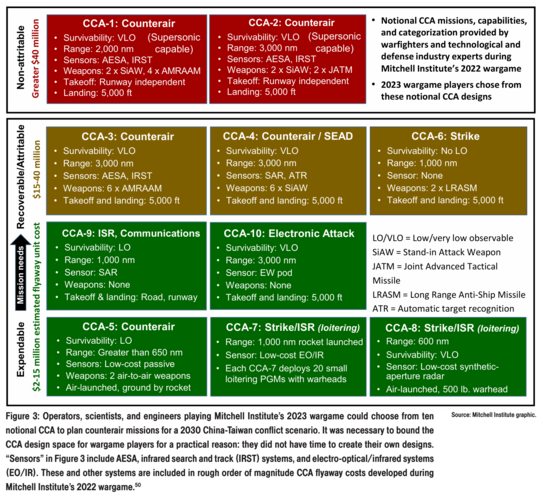
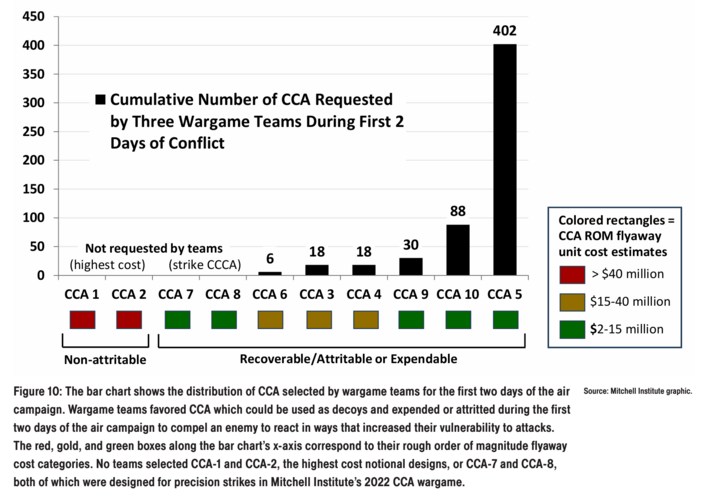
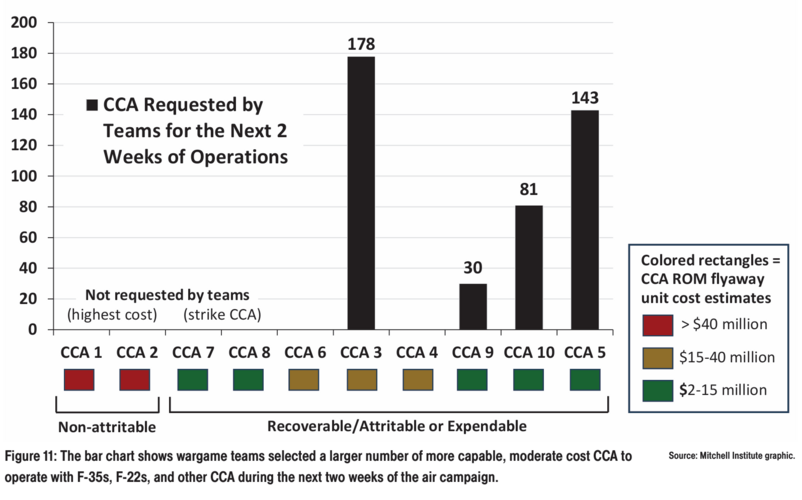
Forest Green
ACCESS: Above Top Secret
- Joined
- 11 June 2019
- Messages
- 9,271
- Reaction score
- 16,770

Experimental Fly-By-Wire UH-60M Black Hawk To Become Autonomy Testbed
Evolving autonomous resupply and other capabilities could open up new and valuable tactical opportunities for the Army's Black Hawk fleets.
Forest Green
ACCESS: Above Top Secret
- Joined
- 11 June 2019
- Messages
- 9,271
- Reaction score
- 16,770

For Replicator 2, Army wants AI-enabled counter-drone tech
The Army may request approval from Congress to reprogram fiscal 2025 funding for initial Replicator 2 systems.

General Atomics could produce CCAs at a rate of one-per-day, exec says - Breaking Defense
General Atomics could scale to build a drone wingman every two days “without lifting a finger” at its existing 5 million square foot production plant in Poway, Calif., the company’s head of aeronautics told Breaking Defense. To go faster, the company would need to expand.
AUSA 2024 — General Atomics could ramp up production of autonomous combat drones to a rate of one aircraft per day in two to three years if given the signal by the Defense Department, the company’s head of aeronautics told Breaking Defense.
At peak production, the dronemaker manufactured one aircraft from its unmanned fleet every three days, for a rate of about 100 per year, Alexander said. “It’s not a far stretch for us to turn that into one per day on a single aircraft with productionization and automation, which we’re investing in today.”
General Atomics could scale to build a CCA every two days “without lifting a finger” at its existing 5 million square foot production plant in Poway, Calif., Alexander said. To go faster, the company would need to expand its footprint with additional facilities, but the level of capital investments required would be “not huge,” he added.
- Joined
- 2 March 2006
- Messages
- 328
- Reaction score
- 231
Some insights on the "Phoenix Ghost" loitering munitions ...

 www.twz.com
www.twz.com

Secretive Phoenix Ghost Kamikaze Drones Rushed To Ukraine Finally Come Out Of The Shadows
Phoenix Ghost was only mentioned but never seen as part of aid for Ukraine that was announced shortly after Russia's invasion began.
Forest Green
ACCESS: Above Top Secret
- Joined
- 11 June 2019
- Messages
- 9,271
- Reaction score
- 16,770

Airbus Successfully Completes First Lakota UH-72 Drone Helicopter Demo for US Marine Corps
Airbus Successfully Completes First Lakota UH-72 Drone Helicopter Demo for US Marine Corps
Forest Green
ACCESS: Above Top Secret
- Joined
- 11 June 2019
- Messages
- 9,271
- Reaction score
- 16,770

General Atomics hints at Gambit UAS Autonomous Combat Airpower from aircraft carriers
General Atomics hints at Gambit UAS Autonomous Combat Airpower from aircraft carriers.

US Switchblade 600 Kamikaze Drone Proves Highly Effective in Ukraine Destroying Russian Tor Air Defense System
US Switchblade 600 Kamikaze Drone Proves Highly Effective in Ukraine Destroying Russian Tor Air Defense System
- Joined
- 1 April 2006
- Messages
- 11,337
- Reaction score
- 9,980
fresh news indeed
General Atomics hints at Gambit UAS Autonomous Combat Airpower from aircraft carriers
General Atomics hints at Gambit UAS Autonomous Combat Airpower from aircraft carriers.armyrecognition.com
Attachments
This forum has devolved into a repository of article links. Most articles and videos posted are surface-level journalism of stuff that is old news or has been rehashed ad nausem.fresh news indeed
Personally, I am grateful to find nearly everyday here the outmost selection of what really matters in the aerospace press and, quite often, beyond. I am glad that other have made their own selections or even highlighted for others the main points. I do also find intuitive scrolling back a thread to quickly find back a report or an extract with the needed information and data I am searching for.
A lack of perfection doesn´t make a failure but the absence of empathy certainly is a sin.
A lack of perfection doesn´t make a failure but the absence of empathy certainly is a sin.
Last edited:
Forest Green
ACCESS: Above Top Secret
- Joined
- 11 June 2019
- Messages
- 9,271
- Reaction score
- 16,770

US Army buys long-flying solar drones to watch over Pacific units
Kraus Hamdani Aerospace has won a Pentagon contract to provide K1000ULE solar-powered unmanned aircraft to the Army and Joint Special Operations Command.
- Joined
- 3 June 2006
- Messages
- 3,086
- Reaction score
- 3,905
Video:Wings Over the Rockies Air & Space Museum said:AI in Military Aviation | Behind the Wings on PBS
Follow the journey of AI in military aviation, from initial concepts in the lab to flight testing. On the outskirts of the Mojave Desert at Edwards’ Test Pilot School, a revolution is taking place in AI piloted aircraft. The one-of-a kind X-62A VISTA in-flight simulator provides a sandbox for flight-testing AI technologies in a controlled setting. AI progress is iterative, and each flight reveals new capabilities and shortcomings. As AI technology progresses towards operationality, the stakes of lethal AI are so high that we’ve got to get it right.
Directed by Cray Novick. Hosted by Tracy LaTourrette.
[...]
00:00 Intro
01:36 Test Pilot School
03:46 History of AI
04:27 Ethics
05:17 The Pentagon
06:36 The Question of Trust
08:00 Simulator to Flight Testing
09:14 The X-62A Vista
12:36 Into the Cockpit
14:24 Flight Brief
15:26 Flight Test
19:15 Opportunities
22:02 Risks
25:07 The Future
25:56 Outro
Link:
Code:
https://youtu.be/UuqJuBxqA-0?si=A0zyRqdIt1MtgHFqGreat feedback on the program. Very interesting to see that they are de-emphasizing the level of achievements Vs the narrative that too often dominates the industry.
Plus, Falcons & Catwalks, what else can you ask for!
Plus, Falcons & Catwalks, what else can you ask for!
Last edited:
jsport
what do you know about surfing Major? you're from-
- Joined
- 27 July 2011
- Messages
- 7,695
- Reaction score
- 5,665

CCA: Everything you need to know about the US military's drone wingman effort [VIDEO #1] - Breaking Defense
In a new video series, the Breaking Defense staff fill you in on the basics you need to know about the Collaborative Combat Aircraft program.
Forest Green
ACCESS: Above Top Secret
- Joined
- 11 June 2019
- Messages
- 9,271
- Reaction score
- 16,770

Air Force: First CCA Models Pass Critical Design Review
The two designs for Collaborative Combat Aircraft passed critical design review this month, allowing detailed production planning to start.
- Joined
- 3 June 2006
- Messages
- 3,086
- Reaction score
- 3,905
Video:Wings Over the Rockies Air & Space Museum said:Collaborative Combat Aircraft | Behind the Wings on PBS
Explore the critical balance in advancing ethical AI technology with Collaborative Combat Aircraft (CCA). Above the white sandy beaches of Eglin Air Force Base, an XQ-58A test aircraft soars by at 35,000 feet. However, there is no pilot, and there’s not even a cockpit! As the capabilities of AI pilots progress, managing the risks of its ethical deployment, and of falling behind in a global race for technological superiority become central to its feasibility.
Directed by Cray Novick. Hosted by Tracy LaTourrette.
[...]
Chapters:
0:00 Intro
1:09 AI Development
3:18 Wargames
4:30 AI Ethics vs. Speed
7:44 The XQ-58
10:38 XQ-58 Walkaround
12:40 Testing CCAs
13:53 Flight Brief
15:18 Mission Control
16:09 Flying With CCAs
20:57 AI Integration
23:48 The XQ-67A
25:13 The Future of AI
25:58 Outro
Link:
Code:
https://youtu.be/e-kP1vZ8lYw?si=oDGd1Fqig_GlWtvhForest Green
ACCESS: Above Top Secret
- Joined
- 11 June 2019
- Messages
- 9,271
- Reaction score
- 16,770

Air Force buying more drone wingmen to develop operational tactics
Anduril's Fury and General Atomics' Gambit are in the running for the first iteration of the Air Force's drone wingman program.
Forest Green
ACCESS: Above Top Secret
- Joined
- 11 June 2019
- Messages
- 9,271
- Reaction score
- 16,770

Air Force: First CCA Models Pass Critical Design Review
The two designs for Collaborative Combat Aircraft passed critical design review this month, allowing detailed production planning to start.

NASA Armstrong builds sensor pod for autonomous flight
Edwards AFB CA (SPX) Nov 13, 2024 - The design and build of a unique NASA pod, produced to advance computer vision for autonomous aviation, was recently completed in-house at NASA's Armstrong Flight Research Center in Edwards, Califor
www.spacewar.com
Forest Green
ACCESS: Above Top Secret
- Joined
- 11 June 2019
- Messages
- 9,271
- Reaction score
- 16,770

Skunk Works Tests See AI-Enabled L-29 Jets Fly Mock Air-To-Air Mission On Orders From Aerial Controller
Lockheed's test highlights ongoing work not just on expanding autonomous air combat drone capabilities, but how humans will interface with them.
Similar threads
-
-
-
Unmanned Long-endurance Tactical Reconnaissance Aircraft (ULTRA): USAF's semi-secret spy drone
- Started by Stargazer
- Replies: 0
-
-

